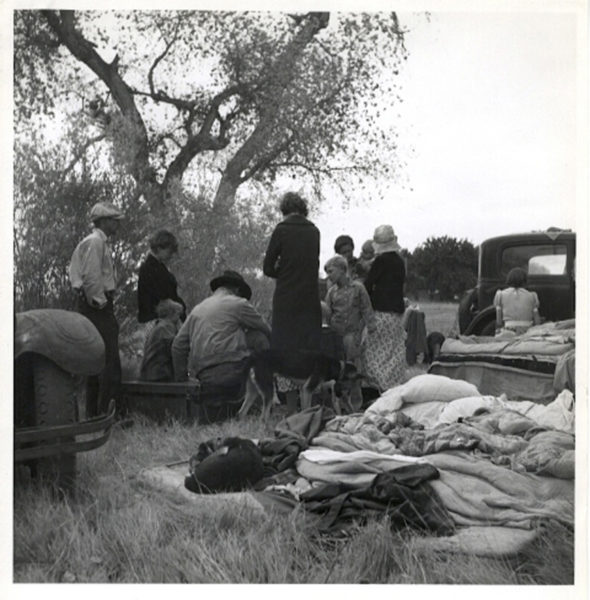
Dorothea Lange, Squatters along highway in Bakersfield, California, 1935, Gelatin silver print, 7 5/8 x 7 5/8 in., Scripps College, Purchase, Scripps Collectors’ Circle
We look for expression in the face, in fact, we say that eyes are the window to the soul, and yet the back, often overlooked, also carries and conveys emotion. We are accustomed to reading the face, but how do we decipher the back? What stories can the back tell?
This exhibition, curated by the interns of the Williamson Gallery, look at works that tell those stories. Alison Saar’s print Washtub Blues encapsulates the weariness of a woman through her bowed back, as she gazes at her reflection in a water basin. In their documentary photography of the Great Depression, Marion Post Wolcott and Dorothea Lange also communicate hardship through the exhausted, bent-over backs of workers. Though his subjects are turned away from the camera, Leonard Freed manages to capture the tension of law enforcement in 1970s New York in his Police Work Series. Photographs of the backs of spectators, also taken by Freed, convey the languid mood of the beach and the pensive atmosphere of a museum. Carrie Mae Weems portrays a sense of alienation in her depiction of the back of a woman of color as she looks toward the entrance of the British Museum—an exclusive Eurocentric art space. Finally, Eva Rubenstein and Horace Bristol use the bare back to simultaneously reveal vulnerability and strength.
This exhibition is part of a tradition: for nine years, Williamson Gallery interns have designed and curated their own show. Due to the current situation, this year’s exhibition is a digital one, containing the highlights of the exhibition as originally planned. We are proud to continue the tradition, albeit in an extraordinary form.
Miriam Bankier ’20, Turk Intern
Annabel Lind ’22, Ludwick Intern
The Great Depression Photodocumentary
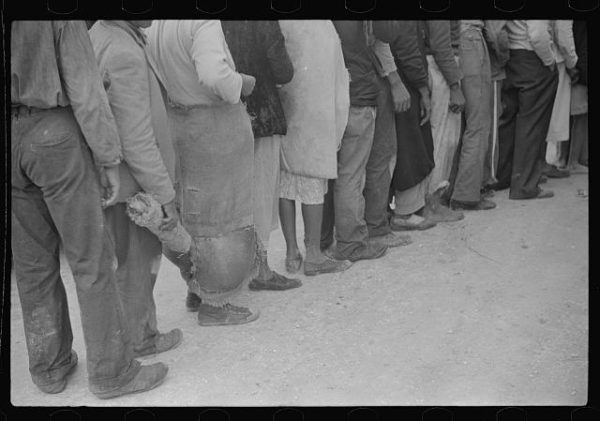
Marion Post Wolcott (1910–1990)
Migrant agricultural workers waiting in line behind truck in the field, for pay for day’s week. Near Belle Glade, Florida, 1939
Gelatin silver print on paper
Scripps College, Gift of Michael Blasgen, in honor of Sharon Walther Blasgen ’64
2018.17.1
The anonymous men and women stand huddled close together in a line, waiting for their pay. All that distinguishes them as individuals is their ragged clothes and worn-out shoes. Wolcott generally used the faces of her subjects to appeal to the emotions of American citizens, but in this image, it is the bodies of the poverty-stricken workers that evoke a powerful response. Each person has their own story, but here the individuals become a unified group, all pushing on to survive.
Kaela Nurmi, Scripps ’15
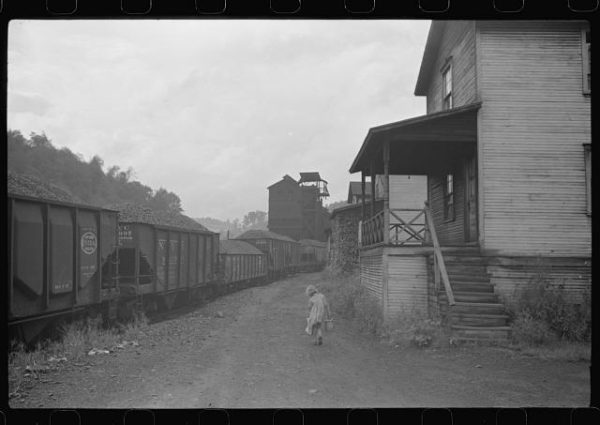
Marion Post Wolcott (1910–1990)
Coal miner’s daughter carrying home can of kerosene to be used in oil lamps. Pursglove, Scott’s Run, West Virginia, 1938
Gelatin silver print on paper
Scripps College, Gift of Michael Blasgen, in honor of Sharon Walther Blasgen ’64
2018.17.2
The ghostly white figure of the young girl bends uncomfortably to the left against the weight of the kerosene can in her right hand. The road extending before her curves to the right in opposition to the child’s back, in contrast with the linear structures surrounding her. The fragility of the girl in the grimy and tattered dress stands out against the backdrop of the sturdy and angular coal-filled train cars.
Kaela Nurmi, Scripps ’15
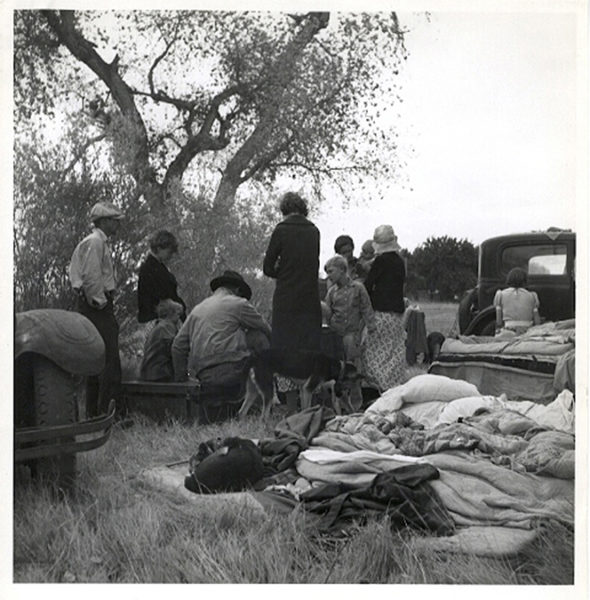
Dorothea Lange (1895–1965)
Squatters along highway in Bakersfield, California, 1935
Gelatin silver print on paper
Scripps College, Purchase, Scripps Collectors’ Circle
2013.3.2
Two subjects dominate Lange’s photographs of the Great Depression: portraits of human suffering and run-down landscapes. Here, those themes meet. A family—migrants from the Dust Bowl that ravaged Canada and the American Great Plains—makes camp in central California. Unlike her portraits, these figures do not confront the viewer. Rather, they exist as part of a decaying landscape, with barren grass and broken down cars. These automobiles, along with the makeshift bedding in the foreground, highlight the migrants’ poverty, and the family’s huddled presence transforms old machinery into a cruel reminder of the 1920s’ roaring failure.
David Kuhio Ahia, Pomona College ’18
Police Work
In his Police Work series, Leonard Freed (1929-2006) set out to photograph the policemen of New York City throughout the 1970s as they followed their daily work routines. Using the back as a vehicle of expression, these four photographs depict suspects as well as policemen in various scenes of action and confrontation. Their backs show fatigue, tension, violence, and death. Although taken in the last century, these images echo current tensions between police and the communities they work in.
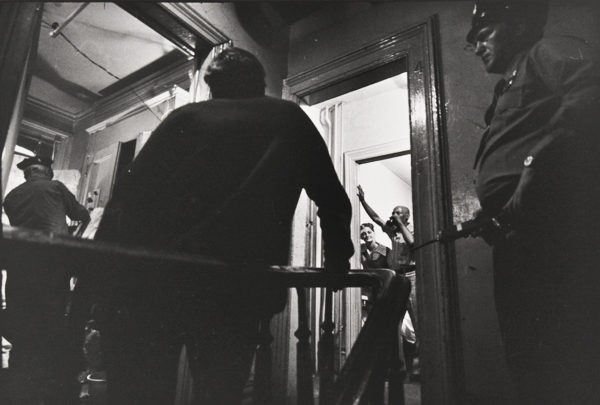
Leonard Freed
Drug Death in Hotel Room, 1976
Gelatin silver print on paper
Scripps College, Gift of Sally Strauss and Andrew E. Tomback
2013.26.43
Freed speaking about the moment this photograph was captured (transcribed from the reverse of the print): “The hotel clerk, the neighbors, his roommate of three years…no one knew a thing about the dead young man in the hotel room—not even his real name, or where he worked. The man lay fallen back on the bed, eyes fixed to the ceiling, a hypodermic needle in his arm. ‘How did this guy die?’ I asked the cop. ‘Dirty drugs.’ I learned later that he had been a police informer.”
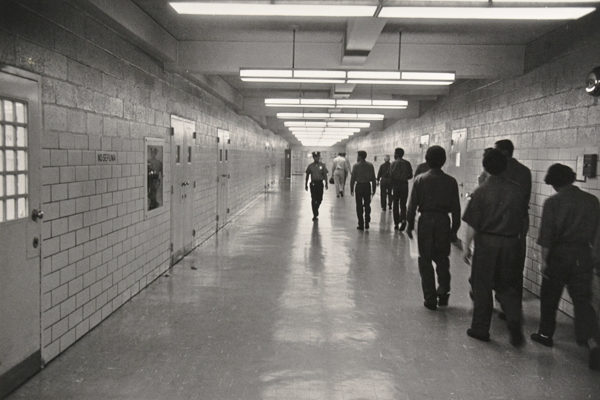
Leonard Freed
House of detention, underground passages, 1976
Gelatin silver print on paper
Scripps College, Gift of Sally Strauss and Andrew E. Tomback
2013.26.42
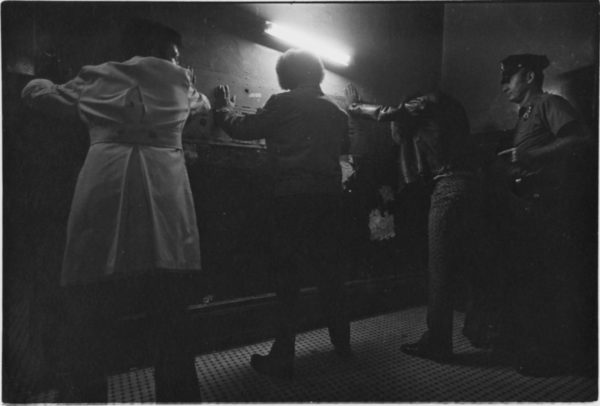
Leonard Freed
“If I had to, I would shoot,” the officer said. “It’s best not to think about it. Anyway, most cops never have a reason to shoot in their whole career. Let’s hope I’m one of them”, 1976
Gelatin silver print on paper
Scripps College, Gift of Sally Strauss and Andrew E. Tomback
2016.15.33
Freed speaking about the moment this photograph was captured (transcribed from the reverse of the print): “New York city police raid a drug hangout and question suspects”.
Cultural Spectator Series:
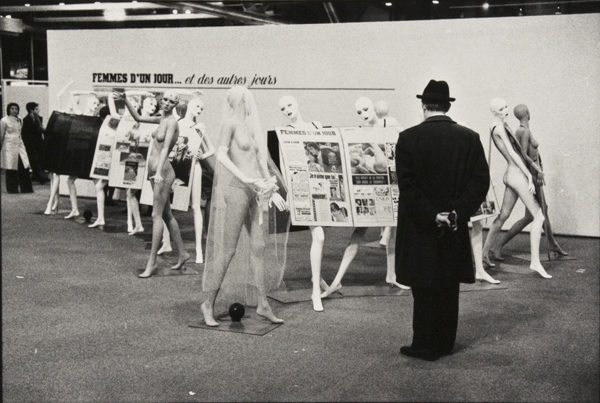
Leonard Freed
Visitor to the Pompidou Center looking at art installation, Paris, France, 1977
Gelatin silver print
Scripps College, Gift of Sally Strauss and Andrew E. Tomback
2013.26.38
This photograph shows tension between the viewer and the art. The man, fully dressed in black, is in contrast with the nude mannequins. Despite leaning toward the work, his posture conveys the way he separates himself from the exhibit. Perhaps this stance is due to his reaction to the exhibition, “Women of one day… and other days”, which aims to confront the ways in which women are presented in the press and in everyday realities with humor.
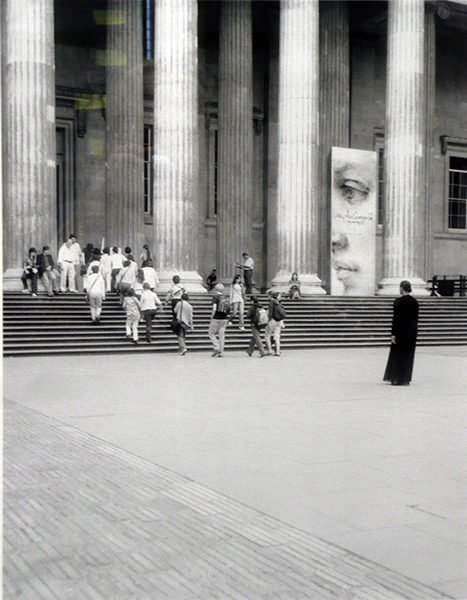
Carrie Mae Weems b. 1953
Untitled (Museum), 2007
Gelatin silver print
Scripps College, Gift of Samella Lewis
2007.2.3
The protagonist of her own photograph, Weems appears in a long black dress, isolated from the group of people passing through the imposing colonnade to the museum entrance. Her inertia contrasts with the movement of the other figures in the frame—only the skirt of her dress lifts in the wind. Weems turns her back on the viewer, seeming to stare longingly at the group of people in front of her, commenting on the exclusion of the black, woman artist from the Western European tradition.
Adapted from the essay “Untitled (Museum)” by Megan Downing ’08, 2007–08 Academic Year Wilson Intern
At Ease:
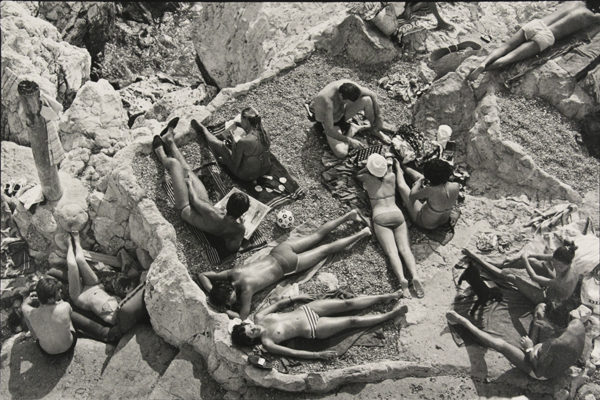
Leonard Freed
Group of people sunbathing on rocks, Côte d’Azur, France, 1981
Gelatin silver print on paper
Scripps College, Gift of Sally Strauss and Andrew E. Tomback
2013.26.24
The sun bathers captured in this photograph repose among rocks, relaxing. A sense of ease and tranquility are strongly conveyed by the figures who lie prone, their backs exposed to the warmth of the sun.
The Back in the Nude:
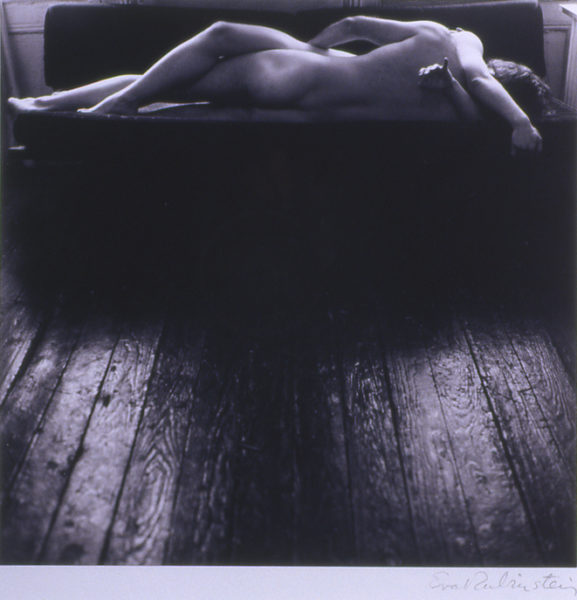
Eva Rubinstein b. 1933
New York, 1970
Gelatin silver print
Scripps College, Purchase, Ames Fund
2002.6.2
Secluded from the commotion typical of New York City, two nude figures cling to each other, turned away from the camera. The lines of the floorboards draw the eye vertically from the details of the wood grain to the exposed back. There is a mysterious narrative in this work, through the unknown relationship between the two figures, and what led to the moment captured. Scripps Alumna Eva Rubinstein’54 leaves the viewer to focus on the back to imagine what lies behind it.
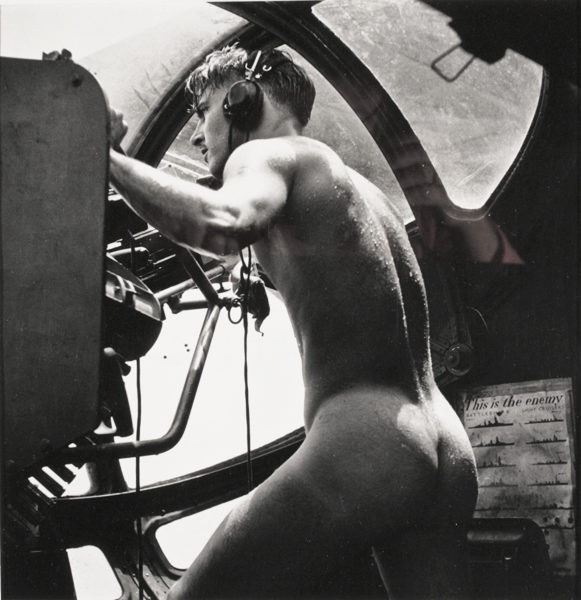
Horace Bristol (1908–1997)
PBY Blister Gunner, 1944
Gelatin silver print on paper
Scripps College, Gift of Louis Newman and Justin Ferate
2013.22.1
This young U.S. Navy crewman has just returned from rescuing a Marine pilot in Rabaul Harbor, who was shot down while bombing the Japanese-held fortress of Rabaul. Since Japanese coastal defense guns were firing at the plane while it was in the water and during take-off, this brave young man worked his position as machine gunner without taking precious time to dress. His exposed back, dripping with sea water and sweat, highlights vulnerability in wartime as well as perseverance through brutal conditions.
Print:
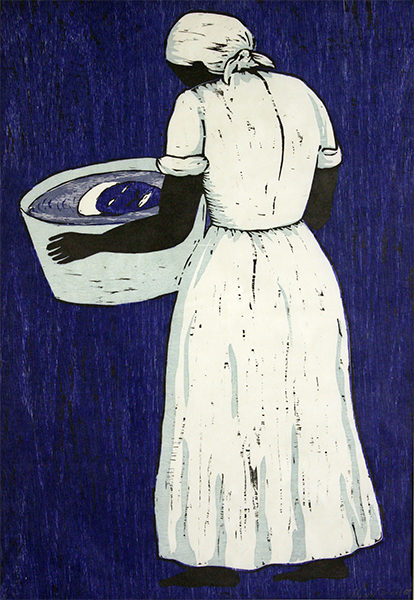
Alison Saar b. 1956
Washtub Blues, 2000
Woodcut on paper
Scripps College, Gift of Alison Saar
2007.7.2
In Washtub Blues, Scripps alumna Alison Saar ’78 continues her career-long exploration of Black female identity. Washtub Blues is a woodcut print that Saar created on commission for the Women of the West Museum and the Boulder Museum of Contemporary Art in Boulder, Colorado for Expanded Visions: Women Artists Print the American West. As a participant in the project, Saar was one of four women artists who worked with printmaker Bud Shark to generate works that drew on their respective, culturally disparate personal experiences. This print shows the back of a barefooted, head-covered black woman holding a washtub. The water in the tub reflects her face, which is not visible otherwise. Almost two-dimensional, the work is a departure from the artist’s trademark sculptural forms. However, the African American female subject and the Black folk aesthetic make the piece distinctly Saar’s.
Written by Zoe Larkins ’09, Summer 2008 Wilson Intern.

